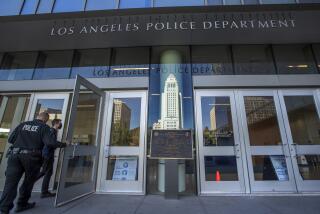Court Says People Injured at Traffic Stop Can Sue CHP
SAN FRANCISCO — Law enforcement officers have a legal duty to ensure the safety of motorists during traffic stops, the California Supreme Court ruled Thursday.
In a 4-2 decision, the court allowed a man and three children who were seriously injured during a speeding stop to seek compensation from the California Highway Patrol at trial.
The four passengers in the car were hurt after an Oceanside-based CHP officer directed the driver of the speeding car to pull onto a freeway median. Once parked in the center of the freeway, the car was struck by a pickup truck. A CHP safety manual advises officers to try to stop vehicles on the right shoulder of the highway.
“A law enforcement officer, in directing a traffic violator to stop in a particular location, has a legal duty to use reasonable care for the safety of the persons in the stopped vehicle,” wrote Chief Justice Ronald M. George for the majority.
Lawyers for the victims said the ruling was an important clarification of the law that will help ensure that officers make traffic stops with safety in mind.
“You really don’t have a choice to disobey the officer if you are asked to do something unsafe,” said attorney Rita Gunasekaran, who handled the appeal for the accident victims. “That is why it is important for the highest court in the state to articulate the policy that the officer must take the safest course of action for the motorist.”
The two justices who dissented, however, predicted that the ruling will make officers more reluctant to stop drivers and will reduce road safety.
“The majority will likely cause more accidents than it prevents because its failure to provide officers with any meaningful guidance does nothing to reduce the possibility of such accidents,” wrote Justice Janice Rogers Brown, who was joined by Justice Marvin Baxter.
Law enforcement enjoys immunity from lawsuits in other familiar situations. For example, police are generally protected from liability when injuries occur during chases, and officers are immune under state law for their decisions to stop suspected traffic violators.
But the state Supreme Court said law enforcement can be sued for negligence if officers expose motorists to danger when they pull them over in traffic.
Thursday’s case, Lugtu v. California Highway Patrol, S088116, grew out of an accident that occurred on California 78 in San Diego County in August 1996.
Shortly before 5 p.m., Richard Hedgecock, an experienced CHP motorcycle officer, saw a Toyota Camry traveling about 85 mph in the fast lane.
Hedgecock pulled his motorcycle to the right of the Camry, sounded his siren and motioned for the driver to stop in the center median.
The officer gave the driver, Michael Lugtu, a dentist, a speeding ticket and cited the front seat passenger, Lugtu’s brother, Cecelio Lugtu, for failing to have placed his two school-age daughters in the back seat in seat belts. The officer also warned the driver to put the third girl, a niece of Michael and Cecelio, in a seat belt. The family members were on their way to see off a relative who was departing on a Navy ship.
As the CHP officer returned to his motorcycle, he saw a pickup truck in the fast lane begin drifting farther and farther into the center of the roadway.
“As the truck approached, Hedgecock waved and jumped up and down, trying to attract the attention of the truck’s driver, James Neeb, who appeared to Hedgecock to be looking down inside the truck,” the court wrote.
“Just as the truck was about to hit him, Hedgecock dove over the concrete median barrier and heard a very loud crash.”
The girls suffered serious injuries, including broken bones, but are now back in school, a lawyer for the victims said.
Cecelio Lugtu, an engineer, received a head injury that has left him with no short-term memory and unable to walk without assistance, the lawyer said. He is confined to a convalescent home. Driver Michael Lugtu, who was outside the car at the time, was uninjured.
Hedgecock said in a court declaration that he stopped the car on the 10-foot-wide median because it would have had to cross two busy lanes to get to the shoulder, which was only 8 feet wide.
He also said CHP procedures give officers the discretion to stop violators in the median or the right shoulder.
The plaintiffs, however, produced a CHP manual that advises officers to direct violators to the shoulder.
A San Diego Superior Court judge ruled for the CHP after determining that the officer had no duty to stop the car on the shoulder. A Court of Appeal in San Diego overturned that decision, ruling that it was up to a jury to determine whether the officer had been negligent.
The California Supreme Court agreed, saying it could find no ruling or law that protects law enforcement officers in such situations. The majority also said Thursday’s ruling will not expose law enforcement to hefty damages in litigation.
The closest California case on point involved a person who was pulled over to the right shoulder by the CHP and was then injured when a drunk driver hit the patrol car, the court said. An appeals court in 1979 said the CHP officer could be found liable, but a jury determined that he was not, the court said.
Juries Qualified to Rule, Chief Justice Says
“The various considerations that an officer is required to take into account in deciding when and where to make a traffic stop, and how to conduct an investigation after the stop, are not beyond the understanding or experience of most jurors,” George wrote.
He said other states also have recognized that law officers have a legal duty to exercise due care during traffic stops and not to expose the drivers and their passengers to an unreasonable risk of injury by third parties.
Justice Brown, however, said the majority failed to consider the policy implications of the ruling.
“If officers may incur liability no matter where they stop a traffic violator, they have less incentive to make stops, resulting in the reduced enforcement of our traffic laws,” Brown wrote.
Deputy Atty. Gen. Karen M. Walter said being a CHP officer “is a tough enough job” as it is without subjecting them to lawsuits over where they stop violators.
“I think it makes it harder for law enforcement officers to work on a busy road,” said Walter, who represented the CHP in the case. “There is a lot more you have to factor in” now.
CHP Commissioner D.O. Helmick said the case will now go to trial. “The CHP welcomes the opportunity to present the facts to a jury,” Helmick said.
Steven W. O’Reilly, the trial lawyer for the accident victims, said the decision “gives added insurance that officers will think a little bit more next time--every time--they pull someone over.”
More to Read
Sign up for Essential California
The most important California stories and recommendations in your inbox every morning.
You may occasionally receive promotional content from the Los Angeles Times.











